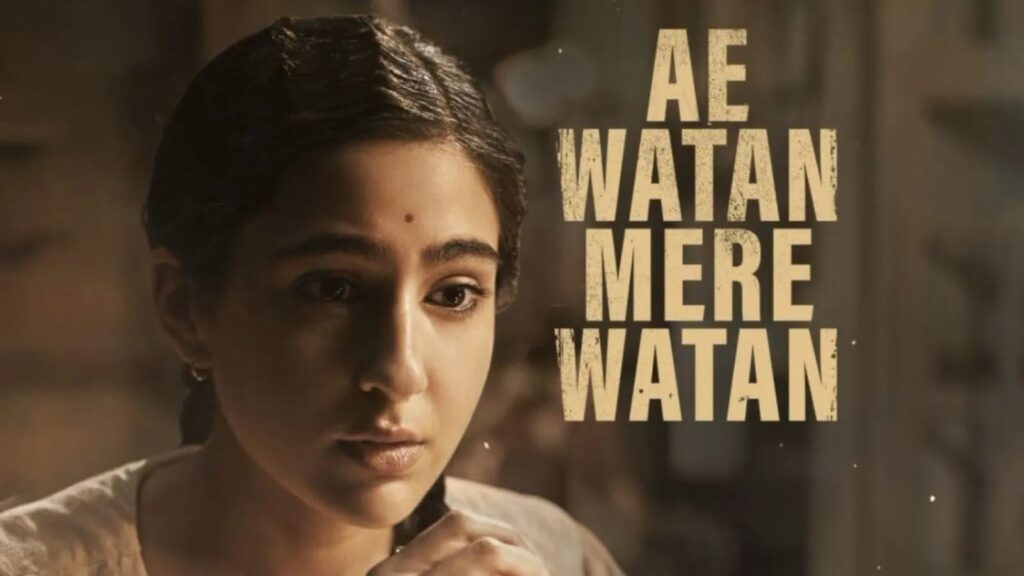Ae Watan Mere Watan,” a recent offering on Amazon Prime Video, dives into the Indian independence struggle through the lens of Usha Mehta, a young woman who played a pivotal role in radio broadcasts against British rule. The film, directed by Kannan Iyer, boasts a star-studded cast featuring Sara Ali Khan and Emraan Hashmi, but the execution leaves viewers with mixed emotions.
A Story of Grit and Sacrifice:
The film chronicles Usha’s journey from a sheltered life to a courageous revolutionary. We see her transform from a young woman yearning for freedom of expression into a key figure in the resistance movement. The narrative highlights the power of radio broadcasts in galvanizing public support for the independence struggle. Sara Ali Khan delivers a decent performance, portraying Usha’s determination and emotional growth.
Beyond the Heroine: Nuances of the Freedom Struggle:
The film attempts to showcase the diverse voices of the freedom movement. We witness the contributions of lesser-known heroes like the young polio-stricken revolutionary (Sparsh Srivastav) who embodies the spirit of resistance. The inclusion of freedom fighter Rash Behari Bose (Naresh Kukreja) adds another layer to the narrative, acknowledging the multi-pronged approach to liberation.
Glorification or Selective Portrayal?
However, “Ae Watan Mere Watan” stumbles in its attempt to strike a balance between historical accuracy and cinematic liberties. The film’s portrayal of the Indian National Congress (INC) as the sole driving force behind the independence movement raises eyebrows. The contributions of other prominent leaders and organizations fighting for freedom are largely sidelined. This one-sided narrative might leave viewers with an incomplete picture of the complex historical reality.
Clichéd Tropes and Predictable Plot:
The film falls prey to some predictable Bollywood tropes. The romantic subplot between Usha and a fictional character (played by Emraan Hashmi) feels forced and detracts from the central narrative. The villainous portrayal of the British officer (Alexx O’Nell) lacks nuance and relies on tired stereotypes.
Technical Aspects: A Mixed Bag:
The production design effectively recreates the period setting, transporting viewers back to the pre-independence era. The cinematography captures the beauty of the Indian landscape and the intensity of the resistance movement. However, the background score can be overbearing at times, drowning out the dialogue and emotional weight of certain scenes.
A Missed Opportunity for Historical Depth:
“Ae Watan Mere Watan” had the potential to be a powerful tribute to the Indian independence struggle. The courage and sacrifices of Usha Mehta and countless others deserved a nuanced and well-researched portrayal. While the film kindles a sense of patriotism, its historical inaccuracies and melodramatic elements leave a lingering feeling of missed opportunity.
Final Verdict: Watch with Reservations
“Ae Watan Mere Watan” is a watchable film with a commendable central performance by Sara Ali Khan. However, viewers seeking a historically accurate depiction of the independence movement might be disappointed by the film’s selective narrative and dramatic execution. If you’re looking for a light historical drama with a dash of romance, this film might be a decent choice. But for those seeking a deeper exploration of the freedom struggle, it’s advisable to look elsewhere.

Here’s a breakdown of the film’s strengths and weaknesses:
Strengths:
- Powerful central performance by Sara Ali Khan
- Highlights the role of radio in the independence movement
- Showcases contributions of lesser-known heroes
Weaknesses:
- Glorification of a single political party
- Predictable plot and clichéd tropes
- The overly dramatic background score
- Lack of historical accuracy and nuance
Overall, “Ae Watan Mere Watan” is a well-intentioned but flawed attempt to portray a pivotal chapter in Indian history. It’s a film to be watched with a critical eye, separating the spirit of patriotism from the shortcomings of its narrative.

